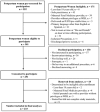Nonurgent and urgent emergency department use during pregnancy: an observational study
- PMID: 27773714
- PMCID: PMC5290191
- DOI: 10.1016/j.ajog.2016.10.013
Nonurgent and urgent emergency department use during pregnancy: an observational study
Abstract
Background: Emergency department use is common among pregnant women. Nonurgent emergency department use may represent care that would be better provided by an established obstetric provider in an ambulatory setting.
Objective: The objective of the study was to identify sociodemographic factors associated with nonurgent emergency department use in pregnancy.
Study design: This is a cross-sectional study of women recruited during their postpartum hospitalization. Data regarding prenatal care and emergency department visits were collected from medical records; participants completed a survey with questions regarding demographics and emergency department use. Urgency of an emergency department visit was prespecified based on a priori criteria abstracted from medical record review. Women with any nonurgent emergency department use were compared with women without nonurgent emergency department use. Logistic regression was performed to identify factors associated with nonurgent emergency department use.
Results: Two hundred thirty-three women participated in this study; 197 (84%) received care in the emergency department during pregnancy. Eighty-three women (35.6%) had at least 1 visit to the emergency department that was nonurgent. In a regression analysis, the increased odds of nonurgent emergency department use was associated with a preferred language other than English (odds ratio, 2.02; 95% confidence interval,1.01-4.05) and lack of private insurance (odds ratio, 5.55; 95% confidence interval, 2.54-12.12). The 2 most common reasons for presentation to the emergency department were concern that there was an emergency (45%) or being referred by a health care provider (36%).
Conclusion: Women frequently use the emergency department during pregnancy, including visits for nonurgent indications. Identifying risk factors for nonurgent emergency department use in pregnancy is important for identifying women likely to use the emergency department, including for nonurgent visits, and the development of strategies to decrease nonurgent emergency department utilization in pregnancy.
Keywords: emergency department; nonurgent emergency department use; pregnancy; prenatal care.
Copyright © 2016 Elsevier Inc. All rights reserved.
Conflict of interest statement
The other authors have no conflict of interest.
Figures
References
-
- Hospital-based emergency care: At the breaking point. Washington, D.C.: Institute of Medicine of the National Academies; 2007.
-
- Moskop JC. Nonurgent care in the emergency department-bane or boon? Virtual Mentor. 2010;12:476–82. - PubMed
-
- A matter of urgency: Reducing emergency department overuse. New England Healthcare Institute: 2010.
-
- Choudhry L, Douglass M, Lewis J, Olson CH, Osterman R, Shah P. The impact of community health centers & community-affiliated health plans on emergency department use. Washington, D.C.: 2007.
Publication types
MeSH terms
Grants and funding
LinkOut - more resources
Full Text Sources
Other Literature Sources
Medical


